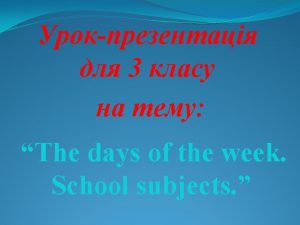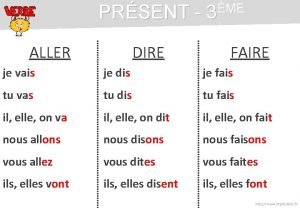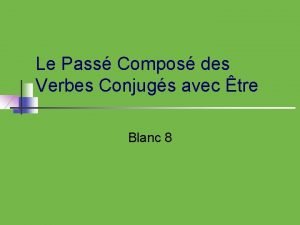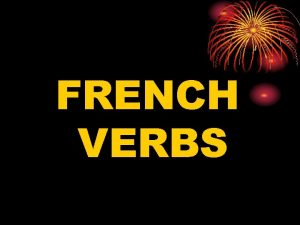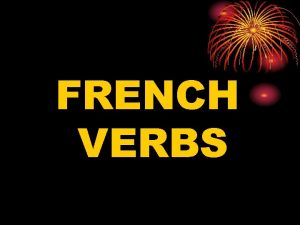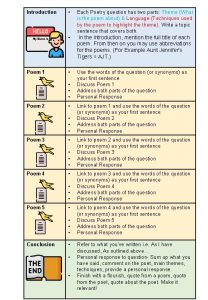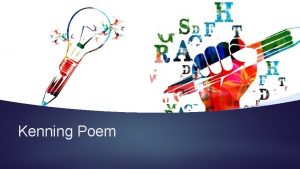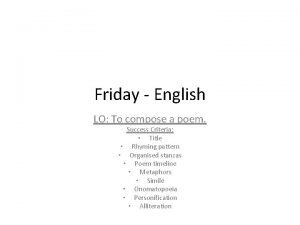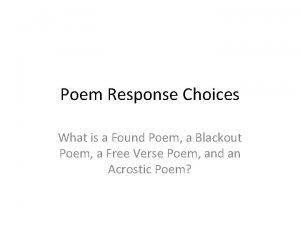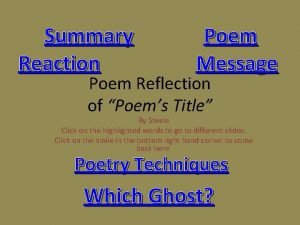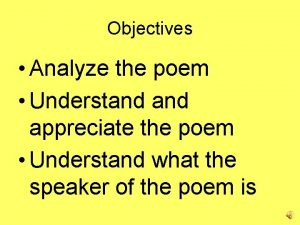Week 1 Compose an Original Poem Compose an







![Blackout Poem • Blackout poems [are normally] created using the pages of old books Blackout Poem • Blackout poems [are normally] created using the pages of old books](https://slidetodoc.com/presentation_image_h2/7ef01c1b72c71d9a73ec15408ce9a316/image-8.jpg)


- Slides: 10

Week 1 Compose an Original Poem Compose an rhyming poem. Rhyming Poem Expectations Week 2 Share a Poem Sidewalk chalk a poem in your neighborhood and take a picture and post it. Sidewalk Chalk Poem Compose a narrative poem. Narrative Poem Expectations Compose a humorous poem. Compose a Poem and share with a Grandparent or Family Member not living in your household. Family Poem Expectations Recite a poem and share the video. Limericks Expectations Video Expectations Week 3 Analyze a Poem Use blackout method to find the most important words in a poem. Explain what the poem means. Blackout Poem How-To Illustrate a poem. Illustrate a Poem How-To Compare a Poem to a Short Film. Paired Text Analysis Expectations

1. It’s the Little Things • Tiny things are all around you! Write a poem about something very small, such as a piece of lint, an M&M, a button, an ant, or a Lego brick. Your poem must be tiny too, containing only five lines Rhyming Poetry 2. Ode to Orange • Write a poem to your favorite color. Include objects, places, or feelings that remind you of that color. • 3. Poetry by the Numbers • Reach for the nearest book and open to a random page. Make a list of 15 words that jump out at you. Write a poem using at least ten of those words.

Narrative Poem Assignment • Now that we’ve explored where poem ideas come from, how poems are structured, and how poems use figurative language and sound devices to make it unique, get ready to create your own narrative poem! Writing a narrative poem can be a lot of fun because it’s all about your unique self. As usual though, there are certain requirements that you will need to include in order to produce your best work. • Your narrative poem must tell a story and include characters, setting, conflict, and a plot. It must also include elements of structure as we’ve discussed in class such as rhythm, lines, line breaks, and stanzas. Lastly, it’ll be important for you to include elements of sound and imagery to activate the reader’s senses and make your poem superb! Narrative Poem Requirements (Hint: Use this as a checklist to make sure you use everything!!!) • Your poem must be: • • • At least 4 stanzas long. Each stanza needs to be at least 4 -8 lines in length. Written in 1 st Person where the speaker is a character in the poem and tells it from his/her perspective (uses “I”). Typed in final draft form (be creative and don’t forget to use white space!) Your poem must have a clear external rhyme and rhyme scheme. (Extra Credit: Use internal rhyme) • Your poem must include at least 2 of the following elements of sound: • • Alliteration Assonance Onomatopoeia Repetition • Your poem must include at least 4 of the following elements of imagery (paint a picture with sensory details): • • Metaphor Simile Personification Hyperbole

Limericks Write a Limerick following the guidelines below: • Complete your limerick using the rhyming pattern A—A—B—B—A. • Indent lines three and four as shown below. • Limericks are usually humorous. It’s okay to be silly! Line 1: rhymes with lines 2 and 5 and has three strong beats (often starts with “There once was …”) Line 2: rhymes with lines 1 and 5 and has three strong beats Line 3: rhymes with line 4 and has two strong beats Line 4: rhymes with line 3 and has two strong beats Line 5: rhymes with lines 1 and 2 and has three strong beats

Sidewalk Chalk Poems • Find a short poem that you relate to or provides vivid imagery when you read it. • Go outside and find a location on your sidewalk or driveway that would be big enough for you to “chalk your poem. ” • Illustrate it if you like! • Take a picture of your chalk poem and post it to the “Poetry Café” collaboration page in your Class Notebook.

Share a Poem with a Family Member • For this activity you will write an original poem. • You may handwrite it, type and print it, and illustrate it if you choose. • Then, you will put it into an envelope and address it to the Family Member you choose to share it with. EVEN if this person LIVES WITH YOU, you must still “Deliver” it to them in an addressed envelope. • Your address should include the following: • • Full Name of Family Member House/Apt. and Street Address City, State, Zip Code Your Complete Return Address in the upper left-hand corner of the envelope. • To get credit for this task, you will need to SHARE your poem with me by either ‘Sharing’ it if you type in a Word Doc, or taking a picture and sending it to me if you hand write it.

Recite a Poem in a Video • For this assignment, you will find a poem that you like and/or speaks to you in some way and will make a video of yourself reading the poem. • First, you will find a poem that means something to you. Use the following links: • • • http: //www. poetryoutloud. org/poems. 20 lines. html http: //www. poets. org/ http: //famouspoetsandpoems. com/ • Then, you will record yourself reading the poem (BONUS – memorize the poem for your video!) • After you have finished your recitation, but included in your video, share the following with your audience: • • -A bit about the author -A bit about the poem -Any interesting facts you learned about this poem or author -The reason that you choose this poem
![Blackout Poem Blackout poems are normally created using the pages of old books Blackout Poem • Blackout poems [are normally] created using the pages of old books](https://slidetodoc.com/presentation_image_h2/7ef01c1b72c71d9a73ec15408ce9a316/image-8.jpg)
Blackout Poem • Blackout poems [are normally] created using the pages of old books or even articles cut from yesterday’s newspaper. • Using the pages of an existing text, blackout poets isolate then piece together single words or short phrases from these texts to create lyrical masterpieces. 1. Find the page of a text you can mark on (and OLD book, magazine or newspaper) or you can find digital text and insert it in the link below. • https: //blackoutpoetry. glitch. me/ 2. Either save the digital blackout poem in a. jpeg (the website directions will show you how to do that) OR take a picture of your actual

Illustrate a Poem Illustrated Poem Guidelines: • Multi-media shows must contain NO LESS than 10 slides and NO MORE than 20 slides. • Each slide must contain at least ONE line from your poem. If your poem is quite long, you may find it necessary to place more than one line of poetry per slide. • Each slide must contain a representative picture/symbol which represents the line of poetry which also appears on the slide. • Choose fonts and colors which are both eye-catching and easily-read in your shows and books. • Shows should also include effective transitions between slides. Bonus points will be awarded for shows that are set to play automatically with at least 10 -15 seconds for each slide and a full minute for the show’s final slide(s). • Bonus points will also be awarded for including music in your presentation. • The final slide(s) in your show will be entitled: Personal Glimpse. This slide will contain a discussion of your poem from the point of view of the poet (not the speaker/narrator). This section allows you to provide the reader with your own analysis of the poem which describes exactly what you feel the poem means and how it is enhanced by your illustrations/images.

Paired Text Analysis • Choose one poem from the following list and read it. Then watch its paired film. Analyze the two by responding to the specific question for that pair. To access the poems and the films, simply click on the links for each. • “The Road Not Taken” and “Lambs” • How can someone make a difference in the world? • “Sonnet 18” and “Scrat Meets Girl” • Is love theme or central idea? If so, to whom or what? • “Be Glad Your Nose is on Your Face” and “Ormie the Pig” • Are people too difficult to please? Do we seem to always want more? Is that what the texts are implying? • “Success is Counted Sweetest” and “The Last Knit” • What does it mean to be successful? Can success be measured? Will we ever reach a point where we feel accomplished? • “Dream Deferred” and “The Wishgranter” • How is the idea of a dream or a wish represented differently in both texts? How does the narrator’s point of view and attitude impact the text’s overall mood and tone?

